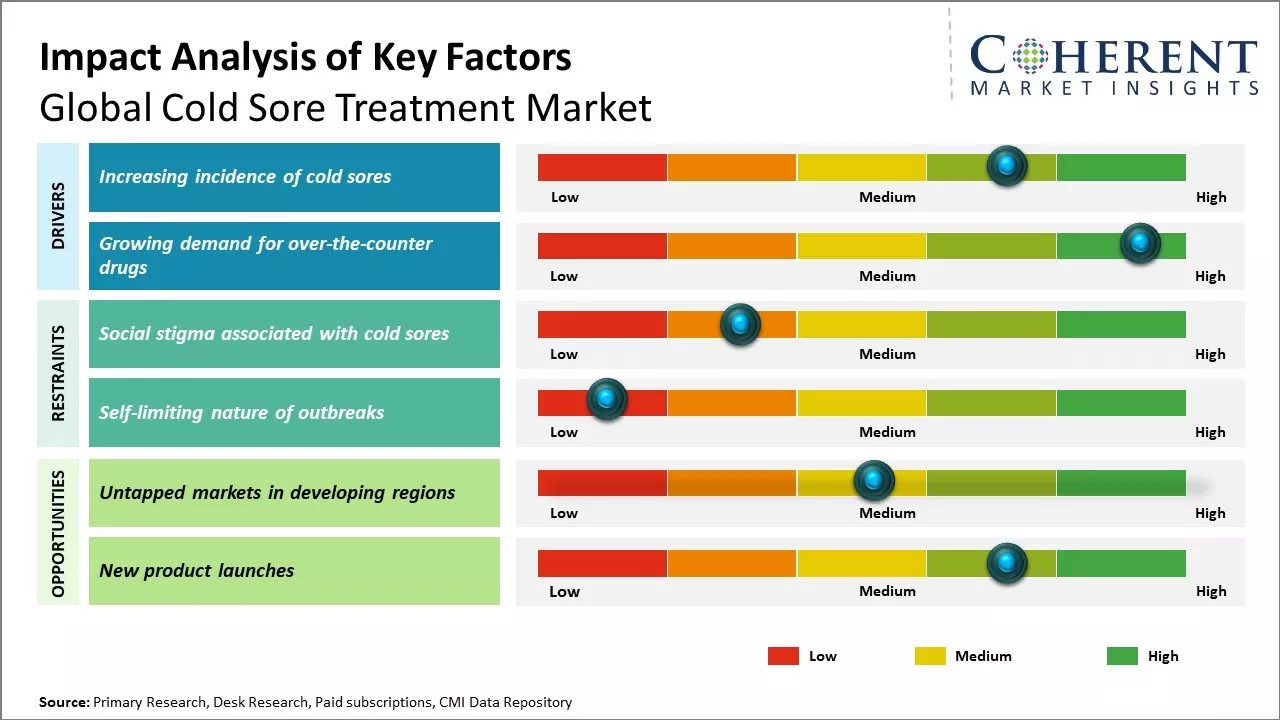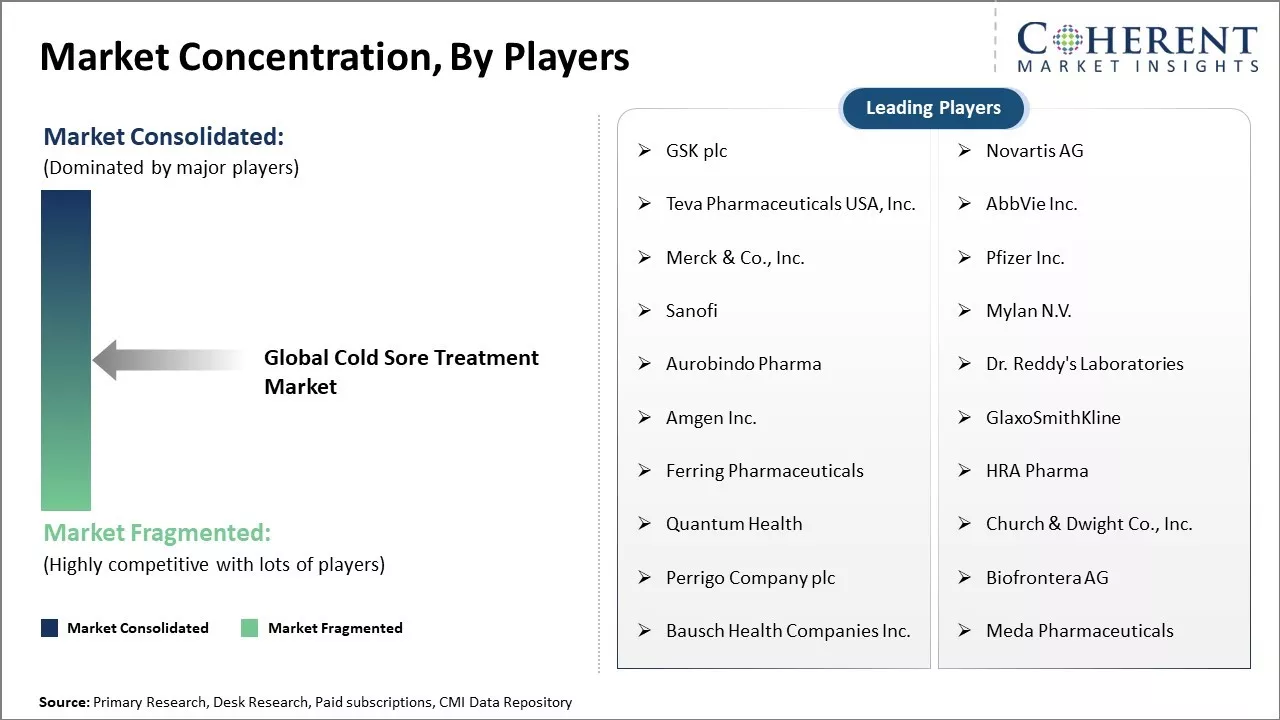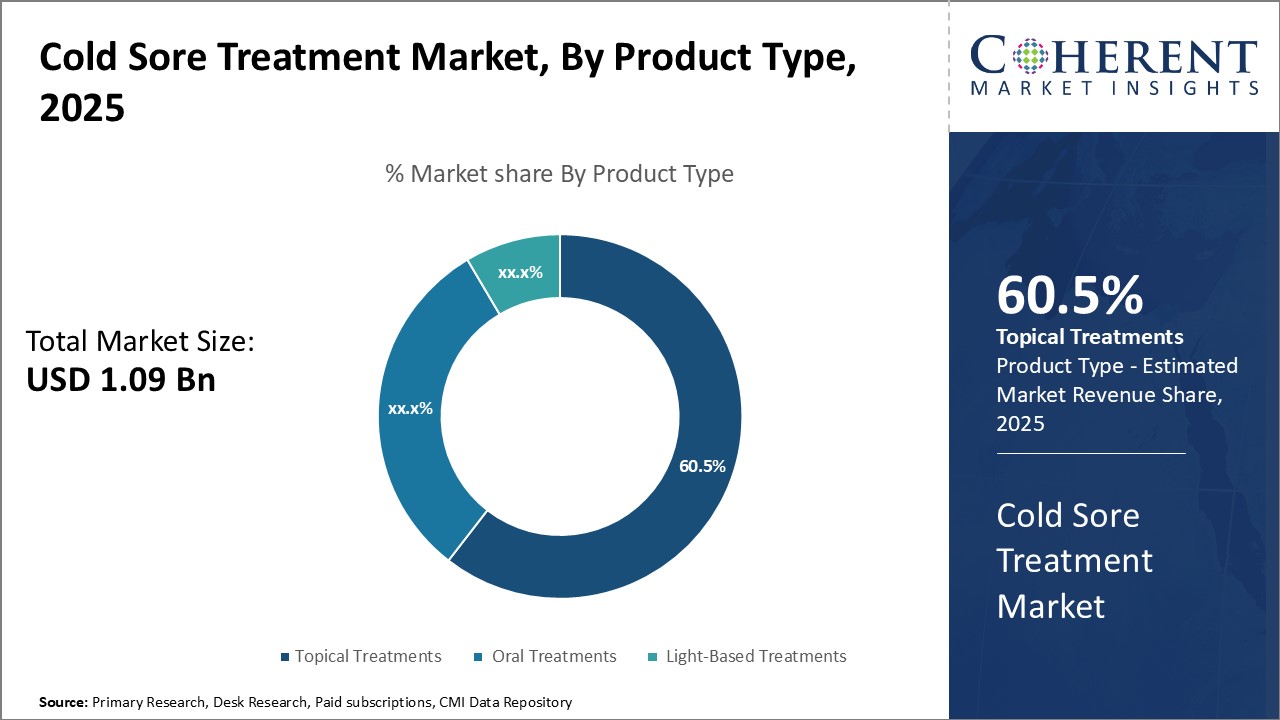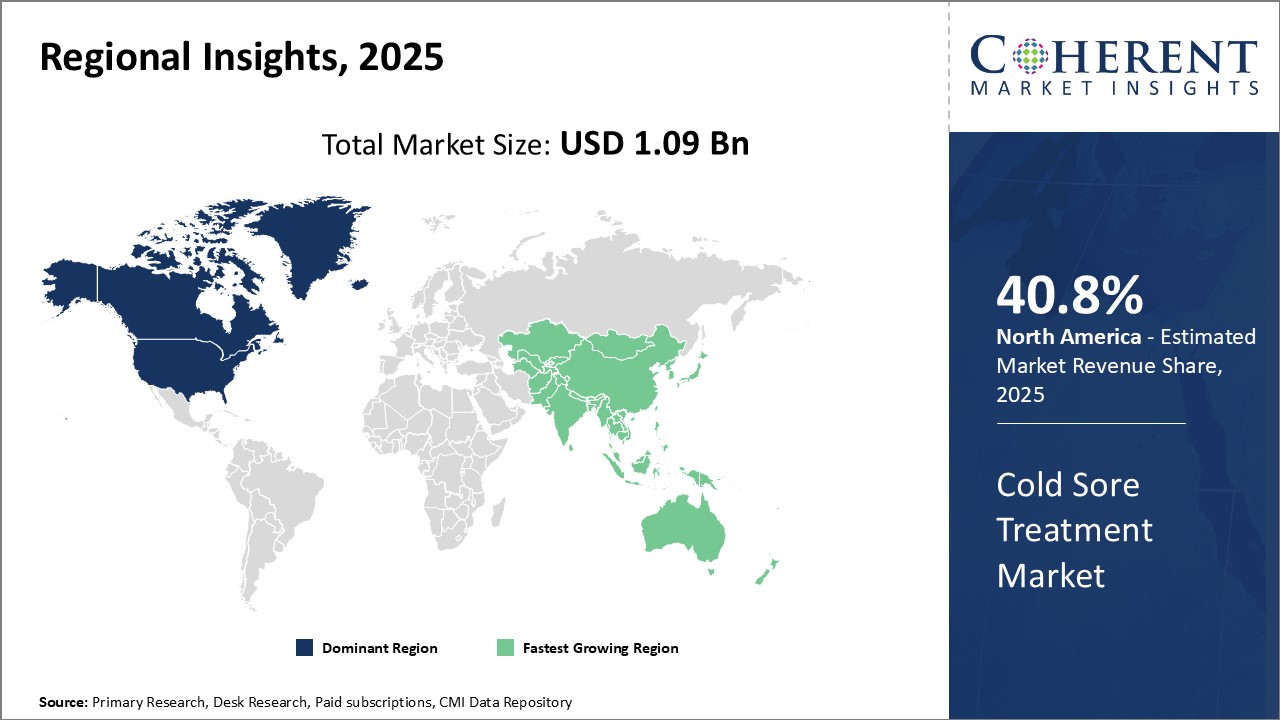Cold Sore Treatment Market Size and Trends
Global cold sore treatment market is estimated to be valued at USD 1.09 Billion in 2025 and is expected to reach USD 1.69 Billion by 2032, exhibiting a compound annual growth rate (CAGR) of 6.5% from 2025 to 2032.

Discover market dynamics shaping the industry: Download Free Sample
Global cold sore treatment market growth is driven by factors such as increasing prevalence of cold sores among the global population coupled with rising awareness regarding available treatment options among consumers. Moreover, development of novel formulations with reduced treatment duration and improved efficacy can also drive the market growth during this forecast period. However, availability of generic and homeopathic alternatives can hamper the market growth. Improving healthcare infrastructure across developing nations and rising consumer spending on personal care a can offer growth opportunities for cold sore treatment market players.
Increasing incidence of cold sores
Rising prevalence of cold sores can drive the market growth. Cold sores, also known as fever blisters or oral herpes, are caused by the herpes simplex virus type 1 (HSV-1). It is a highly contagious disease that can infect people through direct contact with the fluids from cold sores. HSV-1 is extremely common worldwide, with over 3.7 billion people under age 50 infected globally. The risk of contracting the virus is highest during childhood and adolescence. With increasing life expectancy and population growth rates, there has been increase in number of people at risk of developing cold sores. Cold sores are more likely to occur in people with compromised or weakened immune systems. Long-term stress, fatigue, illness, excessive sun exposure can trigger outbreaks. The ubiquitous modern lifestyles with hectic schedules, irregular sleep patterns and improper diets have weakened individual immunity. Moreover, outbreaks are also linked to certain genetic predispositions. Rising prevalence of immuno-compromised conditions like HIV/AIDS, especially in developing regions, has expanded the susceptible population base for cold sores. All these demographic, lifestyle and clinical drivers have contributed to higher prevalence of the virus and increased the likelihood of recurrent cold sore outbreaks among individuals.
Market Concentration and Competitive Landscape

Get actionable strategies to beat competition: Download Free Sample
Growing demand for over-the-counter drugs
There has been growing preference among consumers to self-treat common health conditions without visiting a doctor. Cold sores, being a recurrent but generally mild illness, are often self-treated at home using over-the-counter products. The availability of a wide variety of effective OTC for cold sore treatments can drive the market growth. These include topical antiviral creams containing drugs like acyclovir and penciclovir, lip balm formulations, analgesic gels to relieve pain/tingling sensation, and medicated patches. Consumers find OTC drugs more convenient as these can be purchased easily without a prescription from retail pharmacies and drug stores. This helps save the time and expense of a doctor's visit for a condition that does not require professional medical intervention in most cases. With hectic lifestyles, there has been huge demand for quick and effective self-treatment options. Positive reviews and recommendations shared on digital platforms have boosted confidence in OTC brands. Furthermore, innovative product formats like roll-on applicators and thin films improve consistency of drug application and offer convenience. Growing consumer awareness about trigger management and available treatment options can contribute to increased reliance on OTC medications for self-care of cold sores.
Key Takeaways from Analyst:
Global cold sore treatment market growth is driven by rising cases of cold sores worldwide. The market growth is primarily driven by lack of a permanent cure and recurrence of outbreaks. Rising awareness about available treatment options and over-the-counter drugs can also drive the market growth. However, availability of generic drugs and home remedies can hamper the market growth.
North America currently dominates the market due to advanced healthcare facilities and increased healthcare spending in the region. Meanwhile, Asia Pacific is projected to emerge as the fastest-growing regional market due to rising incidence of viral infections and improving access to healthcare.
Topical antiviral drugs account for maximum market share due to their ease of use and quick symptom relief. Increasing preference for convenient treatment alternatives can boost the sales of topicals over the forecast period. Oral antiviral drugs are also expected to witness lucrative opportunities due to their ability to reduce healing time.
Introduction of advanced formulations such as liquids, gels, and creams incorporating pain-relieving ingredients is a key trend gaining traction among manufacturers and consumers alike.
Market Challenges: Social stigma associated with cold sores
Global cold sore treatment market growth can be hampered due to social stigma associated with cold sores. Cold sores, or fever blisters, are commonly caused by the herpes simplex virus type 1 (HSV-1), which is highly contagious. Over 50% of the global population is estimated to be infected with HSV-1. However, cold sores sufferers are often self-conscious about the appearance of blisters or sores on or around their mouths. This social stigma attached to cold sores acts as a deterrent for many people from openly discussing their condition or seeking treatment. Pharmaceutical companies and product marketers struggle to promote cold sore treatments without seeming insensitive to the social discomfort of sufferers. Addressing the stigma through public health education campaigns about the true nature and prevalence of the virus can normalize cold sores and encourage more people to adopt preventive treatments.
Market Opportunities: Untapped markets in developing regions
Global cold sore treatment market growth is driven by expansion into developing regions of the world. Markets in North America, Western Europe and Japan account for the majority of sales of cold sore treatments worldwide. However, prevalence of HSV-1 infection is equally high if not higher in many developing countries across Asia Pacific, Latin America, Middle East and Africa due to lack of awareness and basic healthcare access. These emerging markets with large population bases offer lucrative prospects for international as well as local players in the cold sore treatment landscape. Pharmaceutical companies need to devise innovative low-cost product formats and affordable pricing strategies customized for customers in developing regions to efficiently tap into this widespread unmet medical need. Expanding distribution networks and conducting awareness initiatives can introduce cold treatments to vast consumer segments that remain unaware of available remedies.

Discover high revenue pocket segments and roadmap to it: Download Free Sample
By Product Type - Ease of application boosts demand for topical treatments
By product type, topical treatments segment is estimated to contribute the highest market share of 60.5% in 2025, owing to their non-invasive nature and ease of application. Creams, ointments, and other topical medications allow patients to conveniently treat cold sores at home without needing to visit a doctor or pharmacy. Popular topical options like acyclovir and penciclovir offer fast-acting relief of symptoms, when applied directly to cold sores. Their external application also eliminates worries about potential side effects from ingesting oral medications.
Among topical treatments, creams and ointments witness high usage due to their hydrating properties. Formulations containing ingredients like lidocaine or benzocaine provide cooling and numbing sensations that lessen pain from cold sores. Ointments create an occlusive barrier over cold sores, protecting the area and speeding up the healing process. Acyclovir remains a top-selling active ingredient in creams and ointments for its proven ability to shorten cold sore durations.
Medicated lip balms containing anti-virals like docosanol offer convenient protection and treatment day or night. Patches containing similar formulations appeal to self-conscious patients as these camouflage lesions discreetly. Meanwhile, acyclovir in topical forms maintains a loyal customer base due to its status as the gold standard treatment. The accessibility and ease of use of topical options can boost their popularity over other product types.
By Cold Sore Type - Convenience drives preference for oral medications
By cold sore type, recurrent outbreaks segment is estimated to contribute the highest market share of 55.5% in 2025, as oral treatments are increasingly preferred due to their superior convenience. Patients who frequently experience cold sores often opt for oral medications rather than the constant application of topical creams or gels. Antiviral drugs such as valacyclovir, famciclovir, and acyclovir offer systemic relief when taken orally, ensuring effective distribution throughout the body. The appeal of short course regimens—where oral medications can be taken at the first sign of a cold sore, typically for just one day—further drives their dominance. This contrasts sharply with topical treatments, which necessitate multiple daily applications.
By Age Group - Embarrassment drives children and adolescent treatment
By age group, children and adolescents segment is estimated to contribute the highest market share of 52.5% in 2025. Lesions appearing on or around the lips can cause immense embarrassment for young people during crucial developmental years. The disfigurement even temporarily hinders abilities to eat, drink, or socialize confidently.
Parents urgently seek fast and hidden treatment options empowering their children’s self-esteem. Topical patches discreetly covering cold sores under masks become popular for allowing normal activity. Medicated lip balms provide soothing effects and camouflage without stigma. Meanwhile, oral medications offer convenience which fosters compliance even amongst minors. Treatment seeks to eliminate cold sores before attending school, camps, or social events.
Regional Insights

Need a Different Region or Segment? Download Free Sample
North America currently dominates the global cold sore treatment market, with an estimated market share of 40.8% in 2025. The U.S. accounts for the bulk of the regional market share, owing to high awareness levels regarding cold sores and available treatment options. Cold sore outbreaks are quite common in the country due to changing weather conditions and high stress levels associated with fast-paced lifestyle. This has resulted in well-established distribution channels for OTC drugs to manage cold sores. Easy access to healthcare also drives the regional market growth. Major players have been aggressive in promoting their branded products through educative campaigns in the region.
The Asia Pacific region has emerged as the fastest growing market for cold sore treatments globally. Countries like China, India and Japan drives the market growth in Asia Pacific. There has been rising prevalence of fever blisters coupled with growing spending capacity on personal healthcare in developing nations. Self-medication is a widely accepted practice for minor ailments like cold sores. Thus, demand for OTC drugs increases at an exponential rate. Western influence and changing consumer lifestyles have led to increased emphasis on aesthetic appearance, making people more conscious about visible symptoms like cold sores. This mindset shift boosts the uptake of anti-viral gels and ointments. Moreover, growing medical tourism from other regions is contributing to large imports.
Market Report Scope
Cold Sore Treatment Market Report Coverage
| Report Coverage | Details | ||
|---|---|---|---|
| Base Year: | 2024 | Market Size in 2025: | USD 1.09 Bn |
| Historical Data for: | 2020 To 2024 | Forecast Period: | 2025 To 2032 |
| Forecast Period 2025 to 2032 CAGR: | 6.5% | 2032 Value Projection: | USD 1.69 Bn |
| Geographies covered: |
|
||
| Segments covered: |
|
||
| Companies covered: |
GSK plc, Novartis AG, Teva Pharmaceuticals USA, Inc., AbbVie Inc., Merck & Co., Inc., Pfizer Inc., Sanofi, Mylan N.V., Aurobindo Pharma, Dr. Reddy's Laboratories, Amgen Inc., GlaxoSmithKline, Ferring Pharmaceuticals, HRA Pharma, Quantum Health, Church & Dwight Co., Inc., Perrigo Company plc, Biofrontera AG, Bausch Health Companies Inc., Meda Pharmaceuticals |
||
| Growth Drivers: |
|
||
| Restraints & Challenges: |
|
||
Uncover macros and micros vetted on 75+ parameters: Get instant access to report
Cold Sore Treatment Industry News
- In February 2024, Abreva promoted confidence among cold sore sufferers by introducing a distinctive, diamond-studded lip design. This striking piece is intended to challenge the stigma surrounding cold sores and encourage individuals to embrace their condition openly. Studies reveal that two-thirds of young people with cold sores experience diminished self-esteem and confidence when have an outbreak.
- In December 2022, BioNTech initiated a Phase 1 clinical trial for BNT163, an mRNA vaccine aimed at preventing genital lesions caused by HSV-2 and potentially HSV-1. The trial will assess the vaccine's safety, tolerability, and effectiveness in inducing an immune response. BNT163 targets three HSV-2 glycoproteins to block HSV entry and spread and counteract its immunosuppressive effects.
- In July 2021, Devirex announced the launch of Lipivir. The company entered a new phase of development, transitioning from lab creation to market distribution. Lipivir lip gel, designed to prevent cold sores, was initially available in pharmacies, drugstores, beauty spas, and online in Switzerland and Austria at the beginning of 2021, following extensive development, research, and testing.
- In November 2020, Amneal Pharmaceuticals, Inc. announced that the FDA had approved its Abbreviated New Drug Application (ANDA) for Acyclovir Cream, 5%. This generic version of Zovirax is used to treat recurrent herpes labialis (cold sores) in immunocompetent adults and adolescents aged 12 and older. The cream is available by prescription only and may cause mild side effects like nausea.
*Definition: Global cold sore treatment market encompasses the sale of drugs and medications designed to address cold sores caused by herpes simplex virus (HSV) types 1 and 2. Cold sores, also referred to as fever blisters or oral herpes, are small, fluid-filled blisters that usually appear on or around the mouth. This market is primarily dominated by topical antiviral treatments that help alleviate symptoms and accelerate the healing process. Key drugs in this category include penciclovir, acyclovir, docosanol, and newer products like Abreva. Additionally, the market features alternative treatments such as topical oils and lip balms that some individuals use to relieve discomfort.
Market Segmentation
- By Product Type Insights (Revenue, USD Bn, 2020 - 2032)
- Topical Treatments
- Creams and Ointments
- Acyclovir
- Penciclovir
- Docosanol
- Other Topical Treatments
- Medicated Lip Balms and Patches
- Oral Treatments
- Antiviral Medications
- Valacyclovir
- Famciclovir
- Acyclovir
- Over-the-Counter Medications
- Light-Based Treatments
- Laser Therapy
- Photodynamic Therapy
- Topical Treatments
- By Cold Sore Type Insights (Revenue, USD Bn, 2020 - 2032)
- Primary Outbreaks
- Recurrent Outbreaks
- By Age Group Insights (Revenue, USD Bn, 2020 - 2032)
- Children and Adolescents
- Adults
- By Distribution Channel Insights (Revenue, USD Bn, 2020 - 2032)
- Hospital Pharmacy
- Retail Pharmacy
- Online Pharmacy
- Regional Insights (Revenue, USD Bn, 2020 - 2032)
- North America
- S.
- Canada
- Latin America
- Brazil
- Argentina
- Mexico
- Rest of Latin America
- Europe
- Germany
- K.
- Spain
- France
- Italy
- Russia
- Rest of Europe
- Asia Pacific
- China
- India
- Japan
- Australia
- South Korea
- ASEAN
- Rest of Asia Pacific
- Middle East
- GCC Countries
- Israel
- Rest of Middle East
- Africa
- South Africa
- North Africa
- Central Africa
- North America
- Key Players Insights
- GSK plc
- Novartis AG
- Teva Pharmaceuticals USA, Inc.
- AbbVie Inc.
- Merck & Co., Inc.
- Pfizer Inc.
- Sanofi
- Mylan N.V.
- Aurobindo Pharma
- Reddy's Laboratories
- Amgen Inc.
- GlaxoSmithKline
- Ferring Pharmaceuticals
- HRA Pharma
- Quantum Health
- Church & Dwight Co., Inc.
- Perrigo Company plc
- Biofrontera AG
- Bausch Health Companies Inc.
- Meda Pharmaceuticals
Share
Share
About Author
Vipul Patil is a dynamic management consultant with 6 years of dedicated experience in the pharmaceutical industry. Known for his analytical acumen and strategic insight, Vipul has successfully partnered with pharmaceutical companies to enhance operational efficiency, cross broader expansion, and navigate the complexities of distribution in markets with high revenue potential.
Missing comfort of reading report in your local language? Find your preferred language :
Transform your Strategy with Exclusive Trending Reports :
Frequently Asked Questions
EXISTING CLIENTELE
Joining thousands of companies around the world committed to making the Excellent Business Solutions.
View All Our Clients
